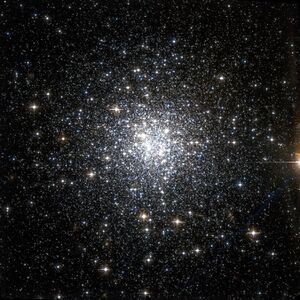Astronomy:NGC 6934
| NGC 6934 | |
|---|---|
 NGC 6934 by Hubble Space Telescope; 3.5′ view | |
| Observation data (J2000 epoch) | |
| Class | VIII[1] |
| Constellation | Delphinus |
| Right ascension | 20h 34m 11.37s[2] |
| Declination | +07° 24′ 16.1″[2] |
| Distance | 52 kly (16 kpc)[3] |
| Apparent magnitude (V) | 8.83[4] |
| Apparent dimensions (V) | 1.20′[5] |
| Physical characteristics | |
| Absolute magnitude | −7.65[6] |
| Mass | 2.95×105[7] M☉ |
| Metallicity | = –1.47[7] dex |
| Other designations | Caldwell 47, NGC 6934[8] |
NGC 6934 (also known as Caldwell 47) is a globular cluster of stars in the northern constellation of Delphinus, about 52 kilolight-years distant from the Sun.[3] It was discovered by the German-born astronomer William Herschel on 24 September 1785.[4] The cluster is following a highly eccentric orbit (with an eccentricity of 0.81) through the Milky Way along an orbital plane that is inclined by 73° to the galactic plane. It may share a common dynamic origin with NGC 5466.[6] As of 2018, it has been poorly studied.[9]
This appears to be a Oosterhoff type I cluster with an intermediate metallicity.[10] It has an Shapley–Sawyer Concentration Class of VIII,[1] with a core radius of 15″[3] and a half-light radius of 36″.[5] The estimated mass is 295,000 times the mass of the Sun.[7] The cluster displays photometric anomalies, with a split subgiant branch on the HR diagram.[9] Searches for variable stars have discovered 85 in the cluster field, of which 79 are of the RR Lyrae class and one is a SX Phe variable.[10] There is some evidence for a tidal tail.[11]
References
- ↑ 1.0 1.1 Shapley, Harlow; Sawyer, Helen B. (August 1927), "A Classification of Globular Clusters", Harvard College Observatory Bulletin 849 (849): 11–14, Bibcode: 1927BHarO.849...11S.
- ↑ 2.0 2.1 Goldsbury, Ryan et al. (December 2010). "The ACS Survey of Galactic Globular Clusters. X. New Determinations of Centers for 65 Clusters". The Astronomical Journal 140 (6): 1830–1837. doi:10.1088/0004-6256/140/6/1830. Bibcode: 2010AJ....140.1830G.
- ↑ 3.0 3.1 3.2 Hessels, J. W. T. et al. (November 2007), "A 1.4 GHz Arecibo Survey for Pulsars in Globular Clusters", The Astrophysical Journal 670 (1): 363–378, doi:10.1086/521780, Bibcode: 2007ApJ...670..363H.
- ↑ 4.0 4.1 NGC 6934, SEDS, http://spider.seds.org/spider/MWGC/n6934.html, retrieved 2010-10-09
- ↑ 5.0 5.1 Forbes, Duncan A. et al. (October 2008). "Uniting old stellar systems: from globular clusters to giant ellipticals". Monthly Notices of the Royal Astronomical Society 389 (4): 1924–1936. doi:10.1111/j.1365-2966.2008.13739.x. Bibcode: 2008MNRAS.389.1924F.
- ↑ 6.0 6.1 Dinescu, Dana I. et al. (October 2001). "Orbits of Globular Clusters in the Outer Galaxy: NGC 7006". The Astronomical Journal 122 (4): 1916–1927. doi:10.1086/323094. Bibcode: 2001AJ....122.1916D.
- ↑ 7.0 7.1 7.2 Boyles, J. et al. (November 2011), "Young Radio Pulsars in Galactic Globular Clusters", The Astrophysical Journal 742 (1): 51, doi:10.1088/0004-637X/742/1/51, Bibcode: 2011ApJ...742...51B.
- ↑ "NGC 6934". SIMBAD. Centre de données astronomiques de Strasbourg. http://simbad.u-strasbg.fr/simbad/sim-basic?Ident=NGC+6934.
- ↑ 9.0 9.1 Marino, A. F. et al. (June 2018). "Metallicity Variations in the Type II Globular Cluster NGC 6934". The Astrophysical Journal 859 (2): 20. doi:10.3847/1538-4357/aabdea. 81. Bibcode: 2018ApJ...859...81M.
- ↑ 10.0 10.1 Kaluzny, J. et al. (March 2001). "Image-Subtraction Photometry of Variable Stars in the Field of the Globular Cluster NGC 6934". The Astronomical Journal 121 (3): 1533–1550. doi:10.1086/319411. Bibcode: 2001AJ....121.1533K.
- ↑ Wilhelm, R. et al. (December 2002). "Does NGC 6934 Have a Tidal Tail?". Bulletin of the American Astronomical Society 34: 1101. Bibcode: 2002AAS...201.0702W.
External links
- NGC 6934 on WikiSky: DSS2, SDSS, GALEX, IRAS, Hydrogen α, X-Ray, Astrophoto, Sky Map, Articles and images
- A Distant Backwater of the Milky Way — ESA/Hubble Picture of the Week
Coordinates: ![]() 20h 34m 11.5s, +07° 24′ 14.9″
20h 34m 11.5s, +07° 24′ 14.9″
 |
